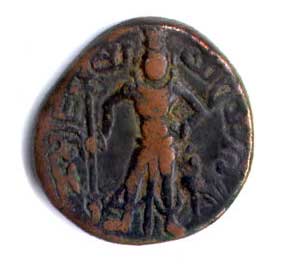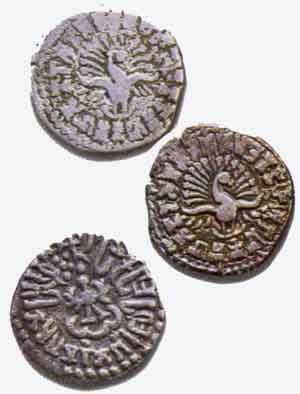
|
|||||||||||||
|
| |||||||||||||
Murukan Worship in Sri Lanka:
|
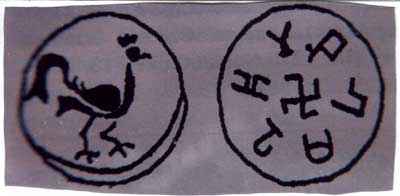 |
Figure 1: A coin from Akkurugoda in southern Sri Lanka registers the figure of a mayil (Skt. mayura) 'peacock' on obverse and the name mahācattan in Brahmi character on reverse. |
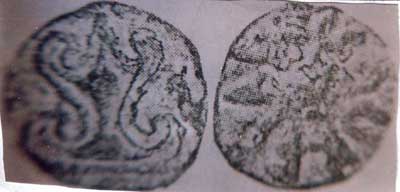 |
Figure 2: A coin dated in the 2nd century B.C. from Kantarotai in Northern Sri Lanka registers the Shrivatsa on obverse and the name Uti(ha)pan in Tamil Brahmi on the reverse. |
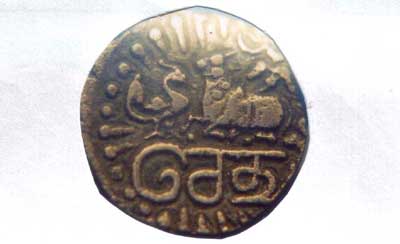 |
Figure 3: Coin issued by the Tamil rulers of Nallūr in Jaffna
who ruled during 13th-17th century A.D. The obverse shows the figure or head of a king
and the reverse illustrates a Nandi (bull vehicle of
Siva) with a peacock facing the Nandi and the word
setu, appearing below the bull. |
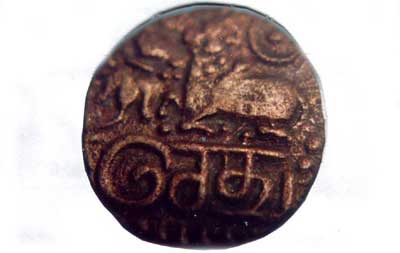 |
Figure 4: In some coins the figure of Murukan replaces the peacock. |
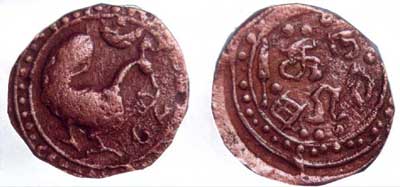 |
Figure 5: Coin on the observe illustrates a moon above with a peacock facing to the right below. The reverse shows in addition to the letters 'kan' the emblem of javelin and the feet of a man. |
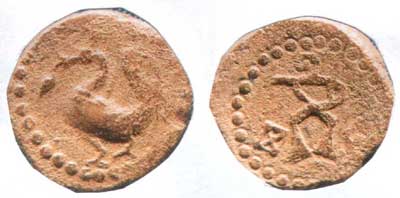 |
Figure 6: Coin showing a snake along with the peacock, both emblems of Murukan. The human figure may indicate the donor-king or Murukan himself. |
Pali literature of the post 5th century A.D. provides evidence of the names of dignitaries as they as well appear in Brahmi inscriptions in the island. Professor Y. Subbarayalu (1989: 92-103) finds a close link between the names of persons and those of gods since naming an individual in the Indian tradition is after some established conventions of which religion is one. Professor S. Paranavitana isolates the personal names found in Sri Lankan Brahmi inscriptions related to Murukan, the best example being Vel (Paranavitana 1970:). Even today in India and Sri Lanka it is not uncommon to come across a person name, e.g. Vēlappan which is rooted in the ancient name Velan appearing in Cankam literature (of Kalidas supra). Definitely it is a pointer of Velan cult.
Due to the impact of Sanskritic tradition of Skanda cult, new names such as Kumāra, Mahāsena and Vishakha (all epithets of Skanda, noted in the Amarakosha, cited in Kalidos 1999) had come into vogue. The Tamil form (of Sanskrit Vishakha) Vicaka appears as the name of a merchant, in an inscription of the 2nd century B.C. from Periyapuliyankulam in northern Sri Lanka (Paranavitana 1970: nos. 356-357). A synonymous name has been reported from the graffiti marked on a mud pot, which was discovered during the Kodumanal excavation, conducted by the Tamil University (cf. Rajan 1994:82). According to Paranavitana (1970: CXXII) these are evidences of Murukan-Skanda cult.
A coin from Akkurugoda in southern Sri Lanka registers the figure of a mayil (Skt. mayura) 'peacock' on obverse and the name mahācattan in Brahmi character on reverse (Bopearachchi 1999:54, Pushparatnam 2001: 43) (see figure 1 at right).
Another coin dated in the 2nd century B.C. from Kantarotai in Northern Sri Lanka registers the Shrivatsa on obverse and the name Uti(ha)pan in Tamil Brahmi on the reverse (Seyone 1998, Pusparatnam 2001) (figure 2).
The Shrivatsa and mayil emblems are reflections of Tamils' religious belief. It is a well known fact that the mayil is the vehicle of Murukan for which ample evidences are found in Cankam literature (Puranaru 65, Tirumurukārruppatai 1.201). So the popularity of Murukan as a god is proved by numismatic sources.
During the 2nd-5th century A.D. a rare type of rectangular coin was in circulation in Sri Lanka. These contain the pranava (sacred ōm syllable), Shrivatsa, Laksmi, elephant, lotus, trishula, bull, Sivalinga, and so on (Parker 1981: 461-482, Peries 1919: 40-67, Bopearachchi 1999, Sitrampalam 1992: 151-158, Sivasamy 1970:1-10, Pusparatnam2001: 90-100). These are reflections of the religious tenor of Śrī Lankan Tamils. The coins with mayil, vel, and ceval are the surest clues of the Murukan cult.
Contemporaneously few of the epithets of Skanda-Murukan also appear in coins of the Indian subcontinent (Gupta 1966:187). Tamil literary sources note the epithets of Murukan such as Vativelan (Cilappatikāram 1:2, 49-50) and Velvelan (Kalittokai 28: 26). Even though the ceval is considered to be the outcome of Aryan interaction, it appears in Tamil tradition of early times yore (Gandhidasan 1988:120).
In medieval Tamil coins in addition to the symbols of Murukan, the Lord's name and his epithets also are noticeable. Good examples are the coins issued by the Tamil rulers of Nallūr in Jaffna who ruled during 13th-17th century A.D. In their early coins the obverse shows the figure or head of a king and the reverse illustrates a Nandi (bull vehicle of Siva) with a peacock facing the Nandi and the word setu, appearing below the bull (figure-3).
The peacock is definitely an emblem of Murukan, who is associated with his father Siva by the Nandi figure. These further confirm the close links between the worship of Siva and Murukan and their relationships as father and son. In some coins the figure of Murukan replaces the peacock (Figure-4).
The present author has discovered coins which bear the letters 'kan' and 'a' on setu-type coins issued by the Tamil kings (Pushparatnam 2001:147-159). On the paleographical grounds these could be assigned to the post-14th century A.D. One type of coins on the observe illustrates a moon above with a peacock facing to the right below. The reverse shows in addition to the letters 'kan' the emblem of javelin and the feet of a man (Figure 5).
Another type of coin shows a snake along with the peacock, both are emblems of Murukan, and the human being may indicate the donor-king or Murukan himself (Figure-6). Such types of coins were issued in the Tamil country also at about the same period (Seetharraman 1996: 89-97).
The letter 'kan' and 'a' and the peacock with snake are clear pointers of the fact that the evidences are sufficient enough to establish the popularization of Murukan cult based on numismatic sources. Jnānacampantar around the 7th century A.D. noted Murukan with the name Kantan (Tēvāram 1.19). At about the same time there was a Tamil king of Jaffna who took the royal title Kantarmalaimalaiyariyarkon (Pathmanathan 1980:409-417). It is quite likely that it is he who appears as 'kan' and 'a' in the coins discussed here. He treated himself as an aryacakravarti king of the Jaffna kingdom. This may be denoted by the letter 'a'. Again the names Kantan and Murukan were very popular in Tamil tradition since time immemorial , at least the Cankam age (Kalidos 1999). Further supports are the emblems, peacock, snake and vel.
The foregoing study based on numismatics provides substantial evidences for the popularity of Murukan worship in Sri Lanka from the ancient period to the 14th century A.D. Later developments of the cult in the island are proved by some great centers of Murukan cult in Sri Lanka as at Kataragama where not only Hindus but Buddhists also visit. The different religious groups of Hindus and Buddhists worshipping at Kataragama is a symbol of religious harmony and unity in diversity. The Kantacastikavacam refers to the Lord at Kataragama with the invocation 'Katirkāmatturai katirvel Murukan' (thanks to Prof. Raju Kalidos who added this note).
The hymns of Arunagirināthar (15th century A.D.) note three centers of Murukan cult in Sri Lanka. They are Kataragama in the South Trincomalee in the East and Jaffna in North. The temples of Murukan in Sri Lanka are generally called Kantan-ālayam (ālayam = kovil 'temple'). Coins bearing the name of kan (tan) seem to be much older in Sri Lanka than in Tamil Nadu. Though Sri Lanka owed much of its culture to the Indian heritage, the island in course of time developed its own religious and cultural characteristics and contributed to its own growth of south Asian civilization. The cult of Murukan is a good example in this context.
References
Bopearachchi, O. and Wickramesinhe,W., Ruhuna an Ancient civilization Revisited, with the collaboration of the Archaeological Deparment, Colombo, Sri Lanka.
Cilappatikāram, ed. Caminataiyar, U.V. VI edition, 1995
Gupta, P.L, Coins, (New Delhi: National Book Trust, 1969)
Kalidos, Raju. History and Culture of Tamil, (Dindugal, 1976)
Kalidos, Raju. "Iconography of Skanda-Murukan: Flashes of Insight" Journal of the Institute of Asian Studies, Vol. XVI 2:73:90, 1999
Kanthtasan, M. Muruka Worship in Tamil Nadu (in Tamil), Madurai 1988
Krishnamurthy, R. Sangam Age Tamil Coins, (Madras: Gamet Publications,1997)
Mahavamsa, Geiger,W. ed., Colombo, 1960
Paranavitana, S. Inscription of Ceylon: Early Brahmi Inscriptions (Colombo: Department of Archaeology, 1970)
Parker, H. Ancient Ceylon (New Delhi: Asian Educational Services, 1981)
Pathmanathan, S. "Coins of Medieval Sri Lanka: The Coins of the Kings of Jaffna", Spolia Zylanica, Vol.35, part I and II:409-417 1980
Peris, P.E., "Nagadipa and Buddhist Remains in Jaffna Port" Journal of the Royal Asiatic Society, Ceylon Branch, , 1922 11-20.
Pusparatnam, P. Ancient Coins of Sri Lankan Tamil (in Tamil), (Jaffna: Bhavani Patippakam, 2001)
Rajan, K. Archaeology of Tamil Nadu Kongu Country (Delhi: Book India Publishing Co., 1994)
Seetharaman, A. "God's Name in Tamil Coins" (in Tamil) in Coins X (Madras: Madras Coins Society, 1998)
Seyon, K.N.V. "Some old Coins Found in Early Ceylon", (Colombo: Nawala, 1998)
Sitrampalam, S.K. "A Note on the Lakshmi Plaques of Sri Lanka" S.S.I.C, II:151-158, 1992
Sitrampalam, S.K. History of Hinduism in Sri Lanka up to 500 A.D. (in Tamil) (Colombo: Jaffna University Publication, 1995)
Sivasamy, V. Coins of Jaffna (in Tamil), Tellippalai, 1974.
Subbarayaiu, Y., "Personal Names and Society" (in Tamil) History and Tamil Inscriptions (unpublished seminar papers), (Tanjavur: Tamil University, 1991) 41-48.
See also these related articles:
"Karttikeya in Early Indian Coinage"
"Skanda-Murukan cult in Batticaloa, Eastern Sri Lanka"
Related research articles about Skanda-Murukan
|
|
